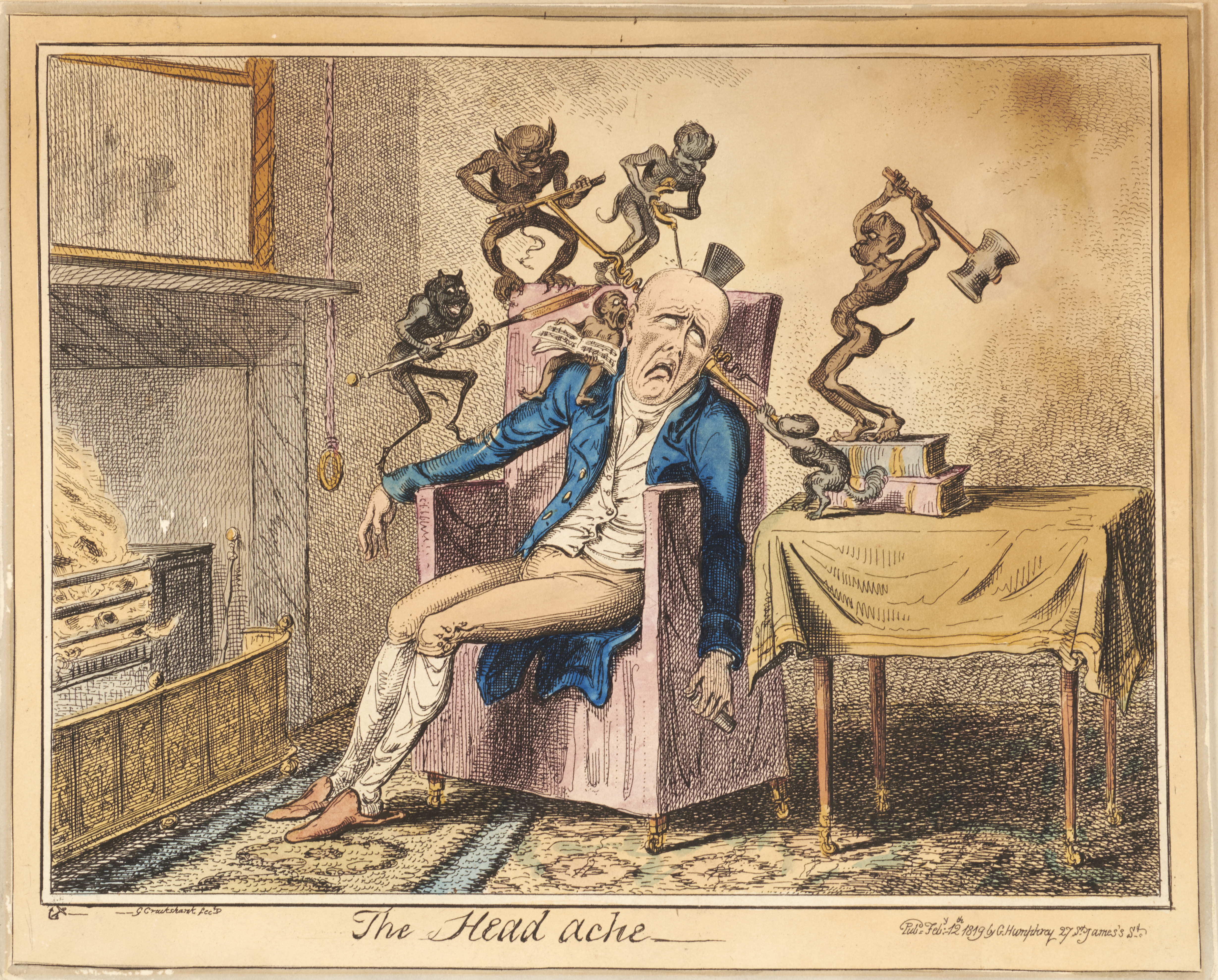
Take a look at this satirical print by George Cruikshank (1792–1878), which is currently on display in our exhibition A taste of one’s own medicine: medical satire at the Royal College of Physicians. Even without the large title written below, the subject of the image is painfully obvious.
As a fellow headache-sufferer, I was immediately struck by how accurately Cruikshank (at least for me) has represented the acute, unrelenting pain that can be caused by this most commonplace of ailments. Like one of the little devils depicted, Cruikshank really hit the nail on the head and conveyed this poor man’s anguish through the use of amusing facial expressions, darkly comical characters, and a wit that would have been greatly appreciated by the artist’s affluent audiences.
Cruikshank’s patient is suffering intensely from his headache. He languishes uselessly in a chair, his arms dangling beside him, his mouth downturned in a grimace and his unseeing eyes rolled to the ceiling. The cause of his anguish – a headache – is represented by six little devils who torment him mercilessly by boring, drilling and hammering a metal wedge into his skull, and by singing loudly and trumpeting in his ears. One grinning devil teases him with a red-hot poker.
The central theme of this image is physical discomfort, which was a recurring motif in medical satire, and is explored in the exhibition. Such a universal theme was probably chosen to appeal to a wide audience – pain is something that everyone experiences and can relate to, no matter which part of society you belong to. I can certainly empathise with this patient, who is overwhelmed by his headache’s ability to incapacitate. Cruikshank no doubt intended this image to amuse his audience, through the use of distorted facial expressions and fanciful characters. Perhaps the image was also intended for healthy viewers, who can be relieved that they are not suffering in the same way themselves.
This image also plays on a common stereotype of the medical profession, which abounded in medical satire at the time: its general ineffectiveness. There is an empty medicine bottle in the patient’s left hand, and a pile of books on the table. Cruikshank is mocking the patient’s failed attempts to treat himself. In turn, the image is also a satirical commentary on modern medicine’s limited ability to cure – in this case medicine is ineffective against the simplest and most commonplace of complaints. It’s difficult to imagine the impact of such a debilitating ailment that can today be so easily cured with a simple pill.
The RCP Museum collections hold approximately 170 satirical images and caricatures, most of which have rarely, if ever, been on public display. These prints have been collected over the RCP’s 500-year history because of their links to medicine and science. The prints are varied and range from obscure newspaper images to visual commentaries on 19th century politics, and to well-known prints by artists including William Hogarth, Thomas Rowlandson, George Cruikshank and James Gillray – in other words artists who are associated with the ‘golden age’ of British satirical print making in the second half of the 18th century.
Cruikshank was a well-known British caricaturist and book illustrator, who was born into a family of artists – his father (Isaac), brother (Robert) and son (George Jr.) all created works of graphic satire. Cruikshank followed in the footsteps of artist James Gillray (1756–1815), and published his works at the publishing house of Hannah Humphrey, located in the West End of London. Cruikshank was greatly influenced by Gillray’s style: he used exaggerated facial expressions to show dark humour, capture reactions, ridicule his subjects and expose hidden personality traits. In 1835 Cruikshank produced three further illustrations of the pain caused by illnesses, again represented by little devils: The blue devils!, Cholic, and Indigestion.
It has been a real pleasure to work on this exhibition which focusses on showcasing extraordinary images like this one. The headache is by far my favourite image in the exhibition – it’s eloquent, original, witty, and so incredibly accurate!
If you’d like to see some more unsettling/gruesome/outrageous images of medical satire, visit our exhibition A taste of one’s own medicine in person or online, until 2 December 2022.
Sarah Backhouse
Exhibitions Officer
